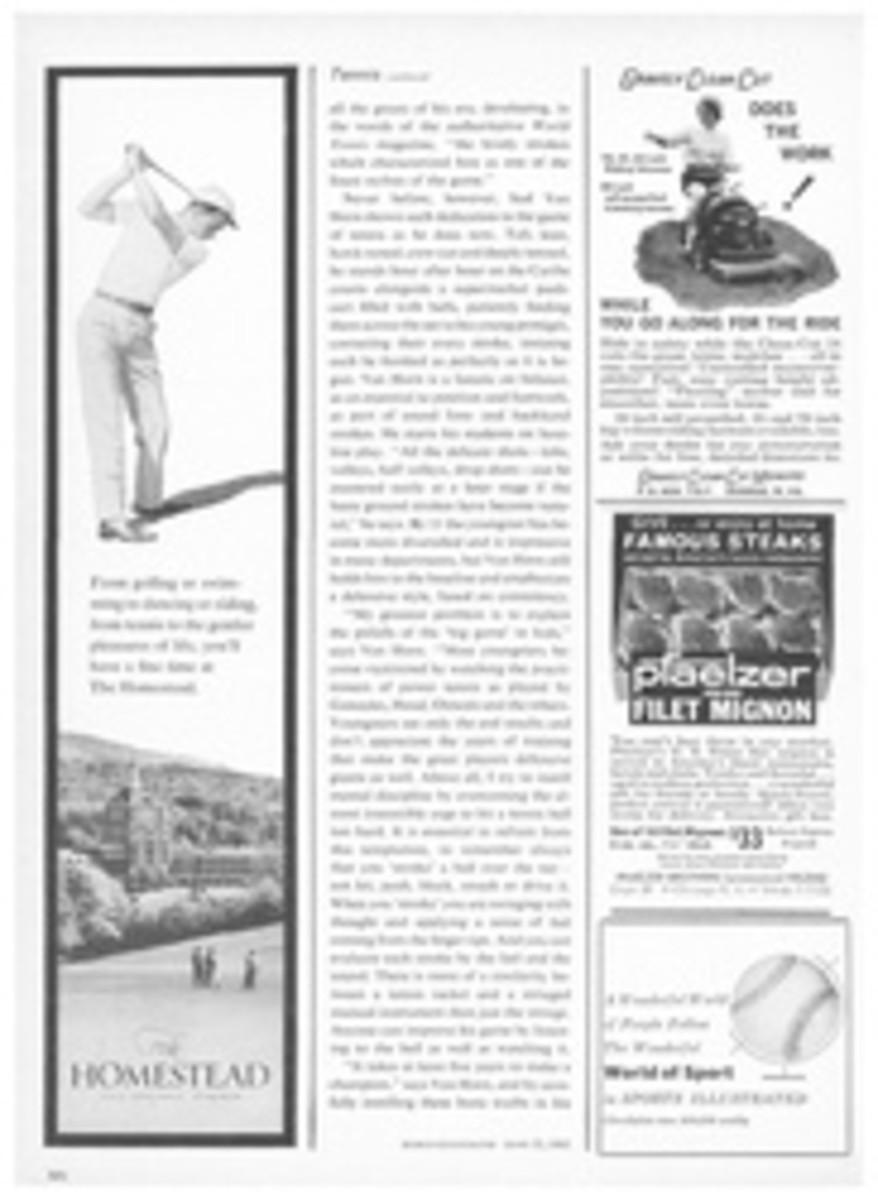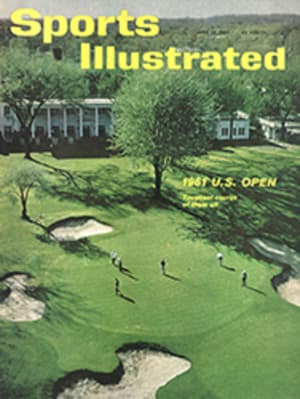
A NEW ERA OPENS AT INDY'S GOLDEN JUBILEE
In all its aspects, last week's Indianapolis 500-mile race was a star-spangled hit. The race itself, on its 50th anniversary, was a marvel of speed and suspense, with seven different leaders and a last-act curtain to take one's breath away. Driver Eddie Sachs, by stopping to change a treadbare tire just three laps from the end, snatched defeat from victory, leaving his pursuer, A. J. Foyt, to claim the $117,975 winner's purse.
Everything else was measured in superlatives: biggest crowd (about 250,000 people); fastest, best-prepared field of cars; largest total purse ($400,000); record average "500" speed (139.130 mph); and even an unparalleled outpouring of nostalgia as Captain Eddie Rickenbacker, Ray Harroun and Earl Cooper circled the speedway in their restored and rackety old Indy racers.
How apple-pie American, how splendid it was—and how deceiving. For besides its cornucopia of American good things, the "500" also contained a small foreign omen for the future. This was the British Cooper-Climax car, driven to ninth place by Australia's World Champion Grand Prix Racer Jack Brabham. The Cooper's presence almost certainly marked the end of an Indianapolis epoch and the beginning of a new one, in which a sharp international rivalry will be added to the Brickyard's matchless wheel-to-wheel competitive spectacle.
The race proved once again that the American Indy roadsters—dominant for nearly ten years—are swift and spectacular. But it also revealed once more the roadsters' less-than-perfect manners and their vulnerability. Apart from the five cars involved in a scary homestretch accident on the 52nd lap, no fewer than 16 roadsters were disabled by mechanical failures before the finish. Mostly to blame were the "terrible power impulses," causing great interior stresses, for which the four-cylinder Indy Offenhauser engines are notorious.
By contrast, the Cooper ran smoothly from start to finish and demonstrated handling qualities far superior to the roadsters. Furthermore, it took a really diehard fan to thrill to the roadster's basic design. Says one impious car owner: "It is a refinement of the prewar passenger car, solid axles and all."
Thus, while giving the roadster full marks, one can honorably and even patriotically suggest that design progress is overdue. Actually, the subject is academic, for the Cooper has generated so much ferment, both abroad and at home, that progress will come willy-nilly.
And if that ninth-place finish seems a trifling accomplishment, consider another first-race precedent: in 1957 Chevrolet, with its vast resources, could make no more than an expensive sputter with the all-out Corvette SS sports car in its one and only race—the Sebring 12 Hours.
Consider also that the Cooper-Climax people (entering Indy for the first time with a car designed in the Grand Prix road racing—not U.S. track racing—tradition and with a maiden "500" driver) made two serious errors in judgment and had one piece of bad luck. The first error was to rely upon soft alloy hub nuts. During each of the Cooper's three pit stops the threads of the right rear hub and wing nut crossed and jammed as a crewman replaced the tire. Mostly because of this, the Cooper crew logged more than twice the pit time of the slickest American crews. The second error was to have Brabham stroke along at 135 to 136 mph in the middle part of the race while the leaders were going up to 10 mph faster. This was done in the hope that only two tire changes would be necessary—but a third stop had to be made anyway, thus adding to the time already squandered in the go-easy move.
Little green fish
Finally, it was Brabham's bad luck to be trapped like a fish in a net in the second flight of racing cars through the laps leading to the big accident (in which, luckily, no one was seriously hurt). The Aussie knew he hadn't enough engine to keep up with the roadsters on the straights. To be competitive, then, he had to produce the record-breaking cornering speeds he had displayed in the prerace trials. But as the early chargers drew away, Brabham found himself boxed in the turns by roadsters "going so slow T could have walked faster," but which he was unable to pass in the following straights.
"We rather mucked it up," said British-born Dr. Frank Falkner of Louisville, Cooper's American representative. "We should have decided on three stops at the beginning and gone fast all the way."
He was echoed by Vic Barlow, a technician for Britain's Dunlop tire firm, which provided special Indy tires for the Cooper. "We are satisfied with the way these tires performed," said Barlow, "but we could have done much better. We are going back now to design a better tire. We've got to get it down to two pit stops."
Brabham affected to be uncertain whether he'd be back in 1962, noting that his wife, whom he calls "Mum," had observed the hair-raising five-car "shunt." "I'll have to see what Mum thinks about it," he said, grinning. But Cooper admitted he would "love to—if they'll have us." There seemed to be no doubt, moreover, that other European factories, all producers of sweet-handling rear-engined cars, would deal themselves in on the rich Hoosier party before very long. Italy's Enzo Ferrari has all but confirmed that he will try to realize next year "the always cherished dream" of winning the "500." England may be represented by Lotuses as well as Coopers. Other possibilities are British Vanwalls and BRMs and Italian Maseratis.
Meanwhile, America's racing corps will be under heavy pressure to develop creative designers rather than mere "builders," who have got by so far by paring a little weight from last year's roadster and squeezing a few more horsepower from the already overworked Offy engine. The most eminent roadster builder, A. J. Watson, says he'll have an independently sprung car in next year's race.
The breakthrough has begun.
TWO ILLUSTRATIONS
CRUCIAL PIT STOPS IN THE "500."
Below, in drawings made on the scene, are those moments of furious action when, in the last stages of the race, the seeming winner had victory torn from him—and then handed back. Young A. J. Foyt sits disconsolate in his Bowes Seal Fast Special (below) as Crewman Frank Catania hurriedly dumps fuel into the tank. Foyt had a small but snug lead and only 16 laps to go when he made this unplanned stop after his engine started missing. Pulling in, he learned to his horror that he had received no fuel in the previous stop—the coupling between hose nozzle and fuel tank had become defective. As Foyt sat with bowed head and Catania worked for 15 frenzied seconds with a borrowed nozzle, Foyt's closest pursuer, Eddie Sachs, took an apparently unbeatable 30-second lead. But, with three laps to go and with no warning, Sachs rolled his Dean Van Lines Special into the pits. His right rear tire had worn to the cord fabric and soon would have blown. With desperate speed a mechanic removed the retaining hub nut, slammed on a new wheel and hammered it home, then (below right) helped push Sachs away. It took only 21 seconds to change the tire. That was too long; Foyt, already in sight on the homestretch, won by 8.28 seconds.

